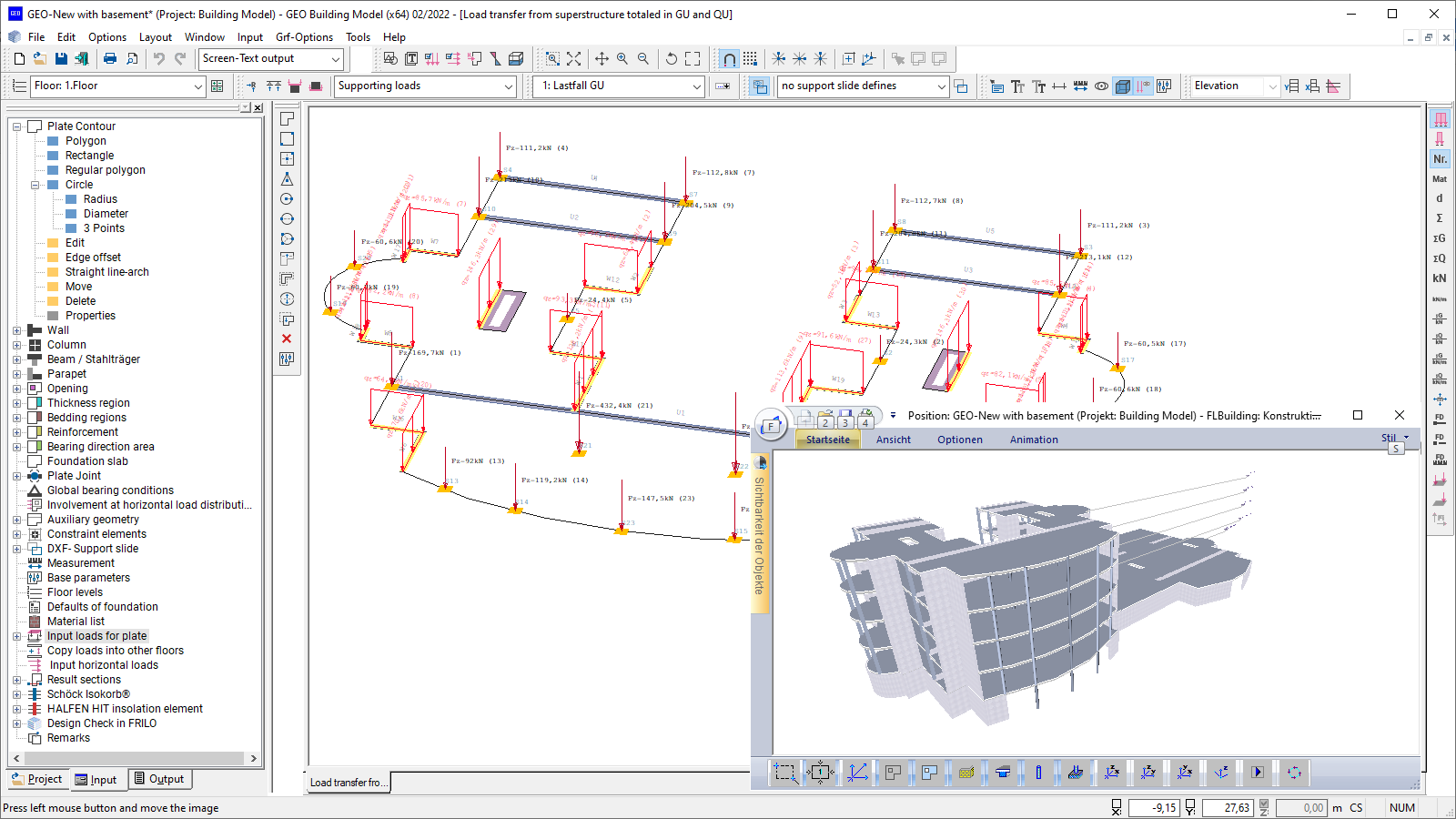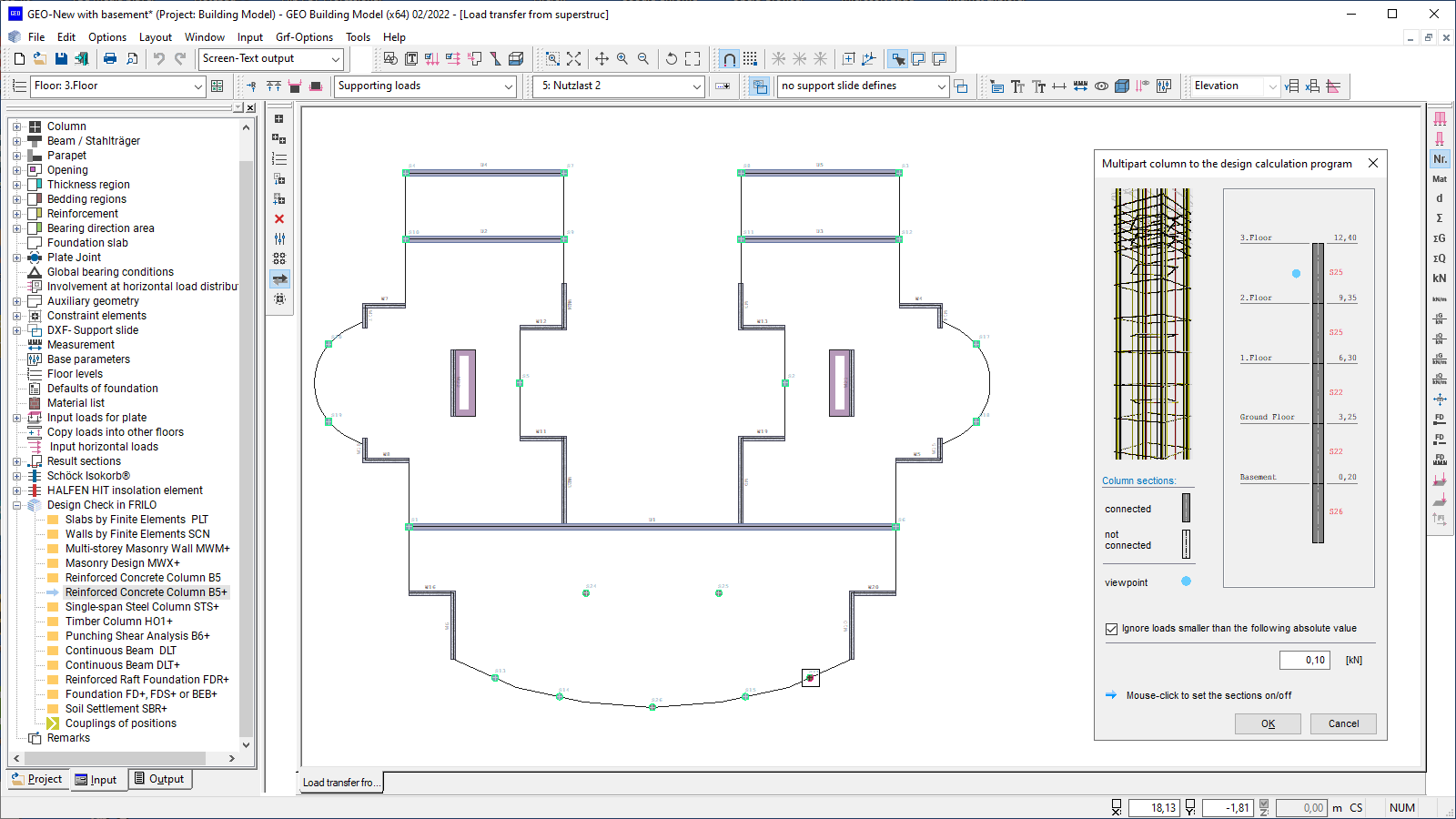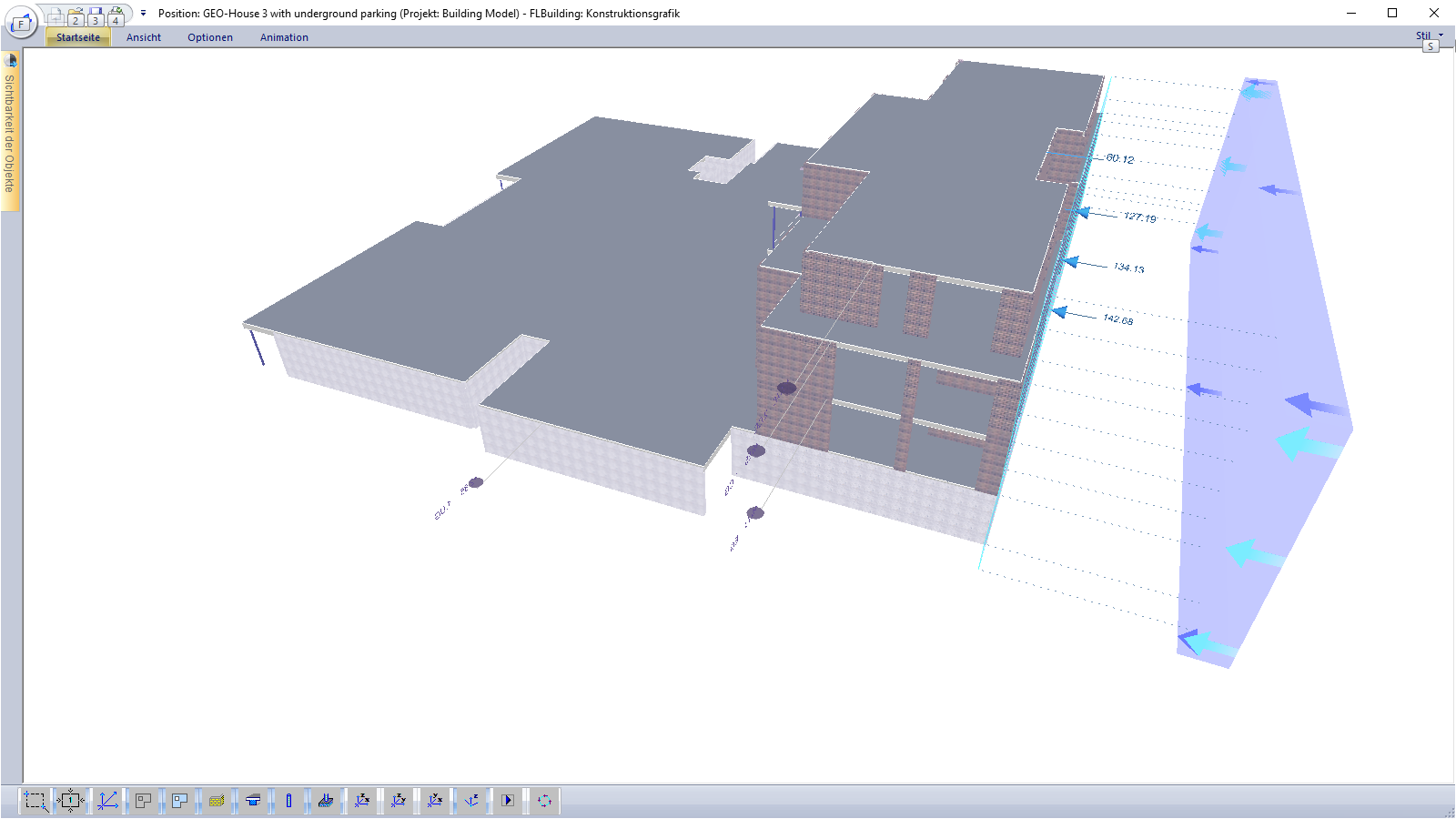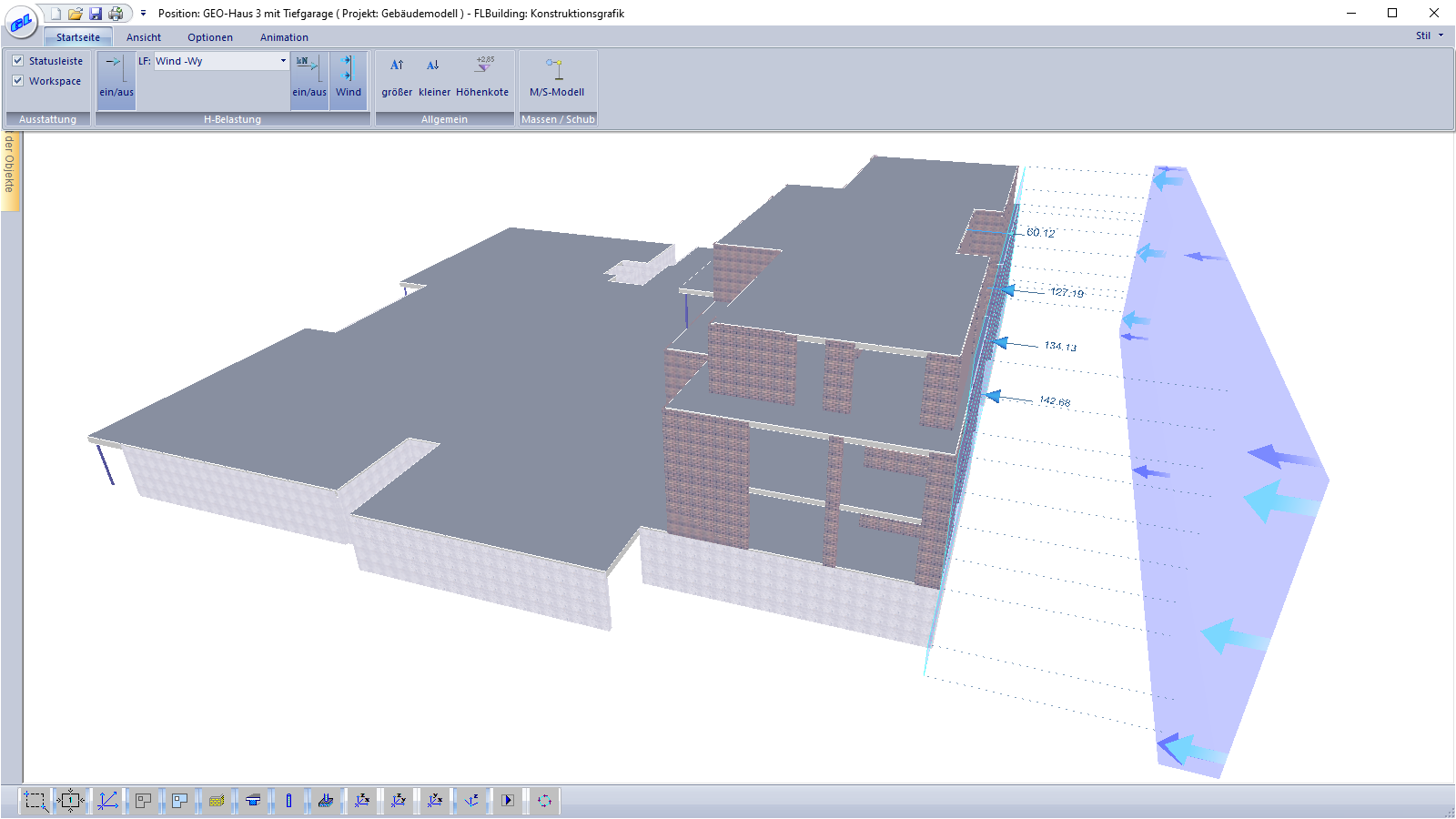
Building Model
GEO
Structures typical in massive building construction are mapped as global load-bearing structures with all structurally relevant components and loads. The building is modelled storey by storey. During this process, mapped storeys can be copied and further edited. Automated processes such as the determination of the horizontal loads and of the self-weight from the material data provided ensure a quick determination of the loads for the intended foundation. A floor slab, foundations, or a mixture of both can be defined for this purpose. Different foundation levels can also be implemented without any problems. A 3D visualisation supports the control of the geometry and the loading. The scope of performance depends on the purchased add-ons.
Discover more products from the FRILO portfolio now!
SHOW MOREInput
Most data are entered interactively in the graphical user interface. To support this, DXF slides can be read in and self-defined auxiliary structures or auxiliary grids can be used. Thanks to a locally definable coordinate system and direction-oriented data entry, points/components can be defined easily and accurately via the graphical user interface or by entering numerical coordinates.
The Undo/Redo functionality allows work steps to be undone/restored, which supports a safe and effective workflow. Various import options, for example via the FRILO BIM-Connector®, top off the data entry.
Special features of the program
Coupling:
If a component is transferred from GEO to another FRILO program for the design, the user can register this item in the building model as a coupled (linked) item. If the corresponding component is accessed subsequently, this item is proposed before the transfer. In most design programs, a coupled item can be used as a template to specifically adopt or adjust properties and loads.
Instability examination:
In order to assess the rotational and lateral stiffness of the building, instability factors are determined. If these are complied with, a more accurate verification in a second-order analysis can be dispensed with.
Bemessung
General
An extensive graphical and tabular output for the creation of structural analysis documents in A4 format is provided. Moreover, all graphics can be put out in the so-called drawing format. Various user-definable title blocks can be used.
Output
The output profile offers a variety of setting options to create an individual structural analysis document. The scale is freely selectable.
Transfer from GEO to
Automatic transfer of the components to the design programs inclusive all loads and action groups:
- Slabs by Finite Elements PLT (transfer of floor slab & all relevant components)
- Walls by Finite Elements SCN (transfer of reinforced concrete walls)
- Multi-storey Masonry Wall MWM+ (transfer of walls from masonry)
- Masonry Design MWX+ (transfer of walls from masonry)
- Reinforced Concrete Column B5/B5+
- Single-span Steel Column STS+ (transfer of cross sections & loads)
- Timber Column HO1+ (transfer of cross sections & loads)
- Punching Shear Analysis B6+
- Continuous Beam DLT/DLT+ (transfer of nodal loads from FE calculation)
- Continuous Beam Steel STM+
- Reinforced Raft Foundation FDR+ (transfer of loads at the base of the walls)
- Isolated Foundation FD+
- Strip Foundation FDS+
- Beam on Elastic Foundation BEB+
- Soil Settlement SBR+
- Pile Foundation Pfahl+
For most interfaces, the vertical support reactions can be added in two so-called superstructure load cases (GU for permanent loads and QU for live loads) or transferred as load case-specific loads in individual load cases. The action groups and alternative groups required for the superposition are also exported.
Transfer to GEO
- FRILO BIM-Connector
Transfer from GEO to SCIA Engineer
Transfer building models created in GEO together with the boundary conditions easily, quickly and directly to SCIA Engineer. A button for direct data transfer is integrated into the GEO program interface. When the button is pressed, SCIA Engineer is started and the building modelled in GEO is immediately displayed in 3D.
SCIA Engineer is a powerful multi-material structural analysis and design software for the design and calculation of three-dimensional buildings of all kinds. As a supplement to GEO, you can use SCIA Engineer:
- Display, calculate and design building models in 3D
- Consider non-linearities in the calculation
- Perform the multimodal response spectrum method for earthquake verification
Reinforced concrete
- DIN EN 1992, DIN 1045 / DIN 1045-1
- ÖNORM EN 1992, ÖNORM B 4700
- UNI EN / NTC 1992
- BS EN 1992
- PN EN 1992
Masonry
- DIN EN 1996, DIN 1053-1/-100
- ÖNORM EN 1996
- BS EN 1996
Wind loads
- DIN 1055-4, EN 1991-1-4 (DIN, ÖNORM, BS)
Sway imperfection
- EN 1992 (DIN, ÖNORM, BS)
- NTC EN 1992
- PN EN 1992
- EN 1992
- DIN 1045 / DIN 1045-1
- ÖNORM B 4700
Earthquake
- DIN 4149-2015, EN 1998-1
- DIN EN 1998-1
- ÖNORM EN 1998-1
Materials for steel columns as per
- DIN EN 1993, DIN 18800
- ÖNORM EN 1993
- BS EN 1993
GEO-HL | Horizontal Load Transfer
With the optional add-on module GEO-HL, horizontal loads generated by wind, inclination and earthquakes can be determined. The wind loads can be calculated depending on the building geometry and the specified wind parameters. Sway imperfections are automatically generated from the calculated vertical loads. The horizontal loads are distributed over the bracing components proportionally to the bending stiffnesses. A contribution to the horizontal load transfer can be defined for groups (e.g. only for reinforced concrete walls) or for individual components.
GEO-EB | Seismic Analysis
With the optional add-on module GEO-EB, seismic loads can be calculated in accordance with DIN EN 1998-1 and DIN 4149, 6.2.2 for Germany or in accordance with ÖNORM B 1998-1:2006/2011, 4.3.3.2 for Austria. The seismic loads are determined using the simplified response spectrum method.
GEO-ME | Measurement of Quantities
The optional add-on module for the determination of the quantities is controlled via the output profile. The user can define the tabular output individually for the different materials and components as well as for individual storeys or even across storeys. The program does not determine the reinforcing steel quantities. The results can optionally be exported to an Excel folder or a CSV file.
Vertical load transfer
The load calculation is carried out storey by storey from top to bottom, whereby the loads of the upper storey are passed on to the storey underneath.
Load types
The available loads are point, line and area loads. For line and area loads, a distinction can be made between constant and non-constant loading. Moreover, temperature loads can be considered. All loads are entered in load cases. These load cases are assigned to action groups already in the building model.
Specialities
The user can subsequently copy load cases from one storey to another. In addition, an automatic transfer of loads from a stored calculated GEO item is available. In the transfer process, the support reactions acting at the base of an existing item are transferred to a selected storey. The user can choose whether the vertical support reactions are added up in two so-called superstructure load cases, each with a constant progression, or whether they are transferred as load-case specific loads in individual load cases. In the building model, the self-weight of all load-bearing components is automatically considered.
Horizontal load transfer
See tab “Additional options”
Slab
All floor slabs can be defined as reinforced concrete slabs. Different thicknesses, different concrete qualities, and different load-bearing directions (uniaxial and biaxial) as well as torsionally resilient and torsionally stiff elements can be defined. The slab is supported by walls and columns or, in the case of base slabs, rests on elastic springs. By defining slab joints, bearing direction areas, reinforcement areas and subgrade areas, the user specifies additional properties that are included in a later design with the Slabs program PLT.
Walls
Walls are used as linear supports for the slab and can be included as rigid or elastic supports. The user can freely define the elastic support or have it automatically determined from the geometry and the material properties. Masonry and concrete are available as materials. Walls can optionally be defined individually or as a connected so-called “wall pillar”.
Columns
Columns are used as point-type supports for the slab and can be included like the walls as rigid or elastic supports. The user can freely define the elastic supports or have them automatically determined from the geometry and the material properties. Masonry, concrete, steel, and timber are available as materials.
Beams
Beams are used as linear stiffeners for the slab. Suspender and downstand beams can be defined. The user can select a concrete quality that differs from the slab concrete quality. In addition to suspender/downstand beams of reinforced concrete, also steel beams can be defined as suspender/downstand beams. All common steel shapes are available for selection.
Parapets
In contrast to suspender/downstand beams, parapets are just used to supplement the self-weight. Masonry and concrete are available as materials. Concrete parapets can also be defined as load-bearing structures. Internally, they are treated like downstand beams in this case.
Support resources
News
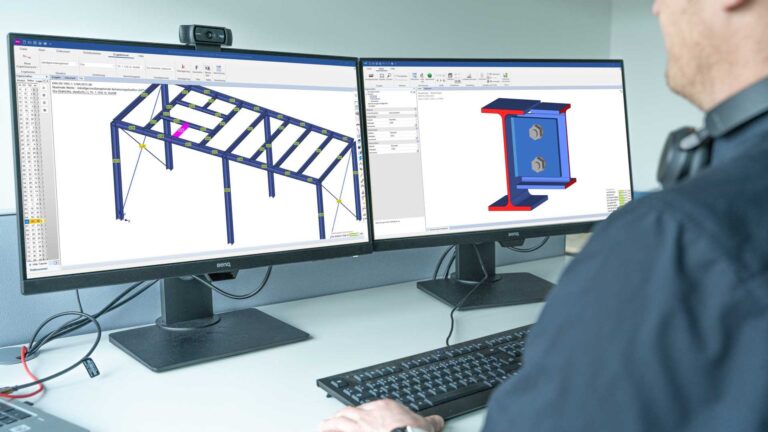
FRILO launches version 2024-2 with powerful updates for structural analysis and design
Highlights include the optimised design of Schöck Isokörbe®, the advanced integration of DC foundation engineering programs into the FRILO environment and new RSX interfaces for detail verifications in steel construction.
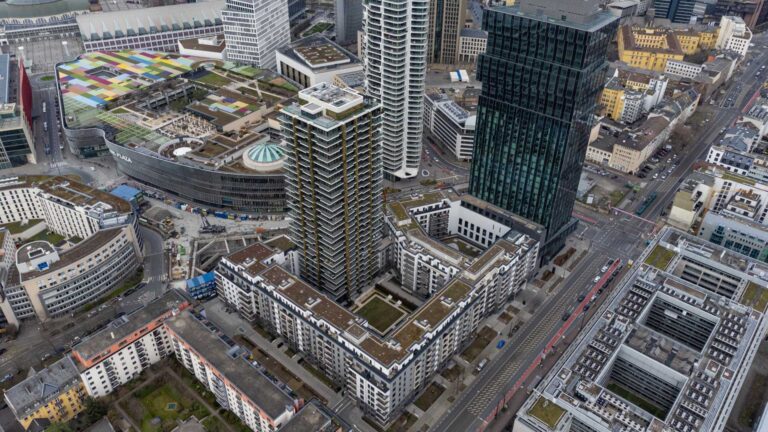
Load determination for eight-floor perimeter block development with FRILO Building Model
Find out how the structural engineers at bauart Konstruktions GmbH determined the loads for an eight-floor perimeter block development in Frankfurt’s Europaviertel district using the GEO from FRILO.

